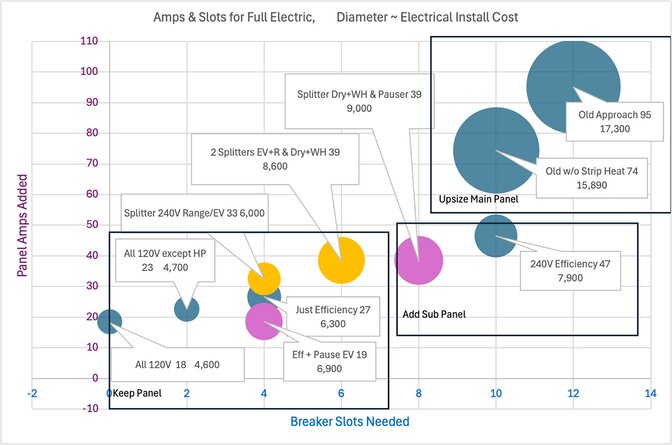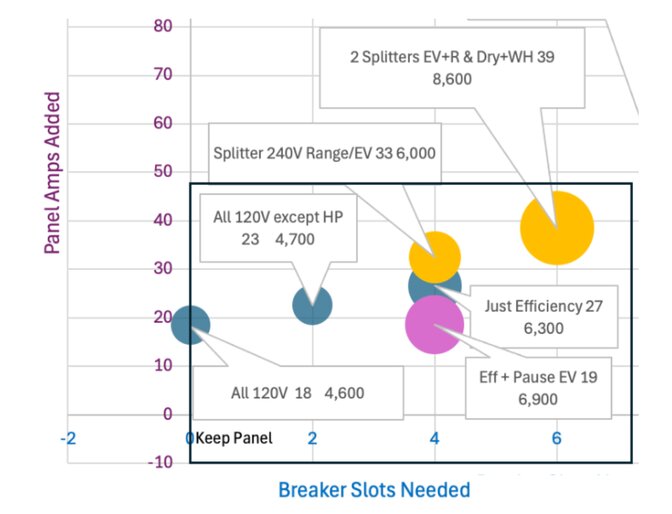This chart may look complicated, but it tells a simple story: There’s more than one way to electrify a home. Let’s explore 11 clever ways to electrify your home—without blowing your budget or your panel.

Chart Explanation
Energy enthusiast and engineer Tom Kabat created this chart for his electrification-curious clients. It shows eleven approaches to add electric appliances to a 2,000 square foot home, ranging from the lowest-cost, most power-efficient design (far left) to the highest-cost, highest-load approach requiring a panel upgrade (far right).
Almost everything can be finessed to avoid panel upsizing.
For Tom, promoting power-efficient design is personal. “Lots of us upsized our panels in prior decades without knowing power-efficient techniques,” he explains. “I wondered, is there a way to use slightly better investments and design in electrification so we don’t have to upsize the panel? And what I’ve found is: Oh yeah. Almost everything can be finessed to avoid panel upsizing.”
If you can save money by making power-efficient choices, you should.
If you can save money by making power-efficient choices, you should, Tom reasons. But without a way to systematically visualize all of your options, “you have to juggle all of these variables in your head.”
Here, Tom takes the variables out of his head and places them into a single chart depicting amps, breaker slots, and electric capital costs, and rolls them up into eleven different options for a single hypothetical home.
Need an introduction to panels and panel upgrades?
Check out our blog Electrical panels: What’s in that (breaker) box?
The X and Y axes: Understand your available amps and breaker slots
When creating an electrification plan for clients or friends, Tom always asks:
- How many breaker slots are available on your panel? In this chart, a home’s available breaker slots are spread along the X-axis.
- How much panel capacity (in amps) is free? Available amps are shown on the Y-axis.
For example, if the house has six available breaker slots and up to 60 amps of panel space, Tom knows he needs to focus on options in the lower-left section of the chart unless the homeowner wants to upsize the panel.

The dot on the far left depicts this home if it has no additional breaker slots and only 18 available amps of service on its panel. Going electric requires truly power-efficient appliance choices, like a 120-volt combination washer-dryer, a 120-volt electric cooktop, and a packaged 2-ton heat pump on 120 volts. (Pro tip: A combo washer-dryer is a particularly great choice because it saves both amps and breaker slots, Tom explains.) It’s doable, but it takes some savvy.
The size of the dots: Calculate the electric capital costs
We all understand that new appliances come with a cost. But a panel upgrade can come at a much greater cost thanks to the additions of utility or city permitting, panel upsizing, and potentially even new wiring to and within your home. These are beyond the expected costs of appliance purchases, so Tom’s chart considers them electric capital costs.
The dot sizes represent the electric capital costs for each of the eleven electrification pathways. Larger dots equal larger costs. To size them accurately, Tom considered:
- Do you need to add branch wiring? This refers to the electrical wires that run from the home’s main panel to the appliances or systems that need power. Some electrification plans, shown in the lower-left corner of the chart, don’t require extra wiring.
- Do you need additional circuits? Some electrification plans require multiple new circuits. For example, the upper-right section of the chart shows plans that require five or six new circuits, plus panel upgrades.
Tom also boxed these pathways into three categories based on whether or not the homeowner would need to upsize their panel:
- Upsize main panel: The two electrification plans in the box at the top right require increasing the size of the electrical panel from 100 amps to 200 amps or more. This is because the new electrical loads need more power than the original panel can handle.
- Add sub panel: The three plans in the middle below require installing a subpanel. A subpanel is a smaller electrical panel connected to the main panel that helps distribute power more efficiently without needing a full panel upgrade.
- Keep panel: The electrification plans in the lower left can work with the home's existing 100-amp panel, meaning no panel upgrade or subpanel installation is needed.
The color of the dots: Install special controls
Panel upsizing isn’t an either/or proposition. Tools, devices, and controls are available to monitor and toggle a home’s electric loads, potentially allowing a homeowner to install power-hungry devices without the cost of a panel upgrade.
This chart color-codes the pathways depending on whether they require special controls.
- Blue dots = no controls: These plans didn’t require special controls. All five major appliance uses—cooking, space heating, water heating, car charging, and clothes drying—operated on high-powered 240-volt circuits, with more efficient equipment.
- Purple dots = circuit pausers: These plans used circuit pausers, which can pause the usage of a high-powered appliance, typically an EV charger, if the main panel reaches 80% of its capacity. The pauser checks the panel load every 15 minutes and resumes EV charging once demand decreases. (“In real life, this might only happen once or twice a year—perhaps during your annual winter cookie-baking party while running the dryer and charging the car at the same time,” says Tom.)
- Yellow dots = circuit splitters: These plans used circuit splitters, also known as circuit sharers. A splitter allows two appliances to share a circuit—for example, a dryer and a car charger. A homeowner chooses which appliance should get priority, and which is subordinate. “A heat pump water heater is a good subordinate device on a circuit splitter, because it has a storage tank,” Tom explains. “Cooking appliances are a bad fit as a subordinate device because we don’t want our water heater deciding when we can cook dinner!”
What home electrification path will you take?
Home electrification is sometimes presented as a binary—you either upgrade to electric appliances, or you don’t. Tom’s chart shows us that couldn’t be further from the truth. Homeowners have numerous options. Your starting point, your existing panel, your goals, your driving needs and preferences, and more can all influence your preferred pathway to electrification.
Home electrification is sometimes presented as a binary—you either upgrade to electric appliances, or you don’t. Tom’s chart shows us that couldn’t be further from the truth. Homeowners have numerous options. Your starting point, your existing panel, your goals, your driving needs and preferences, and more can all influence your preferred pathway to electrification.
Your starting point, your existing panel, your goals, your driving needs and preferences, and more can all influence your preferred pathway to electrification.
Whichever pathway you take, we’ve got your back. The Switch Is On shares the solutions, incentives, and products that help you electrify your way.
Find a contractor to help you chart your electrification course.